WCH10 Borneo!
Our group is just back from the 10th World Congress of Herpetology, Kuching, Sarawak, Borneo! With 1500+ participants this was one of the largest conferences ever. With 10 participants our group was well represented and our research was communicated in quite many talks and posters, below some impressions from this amazing event.


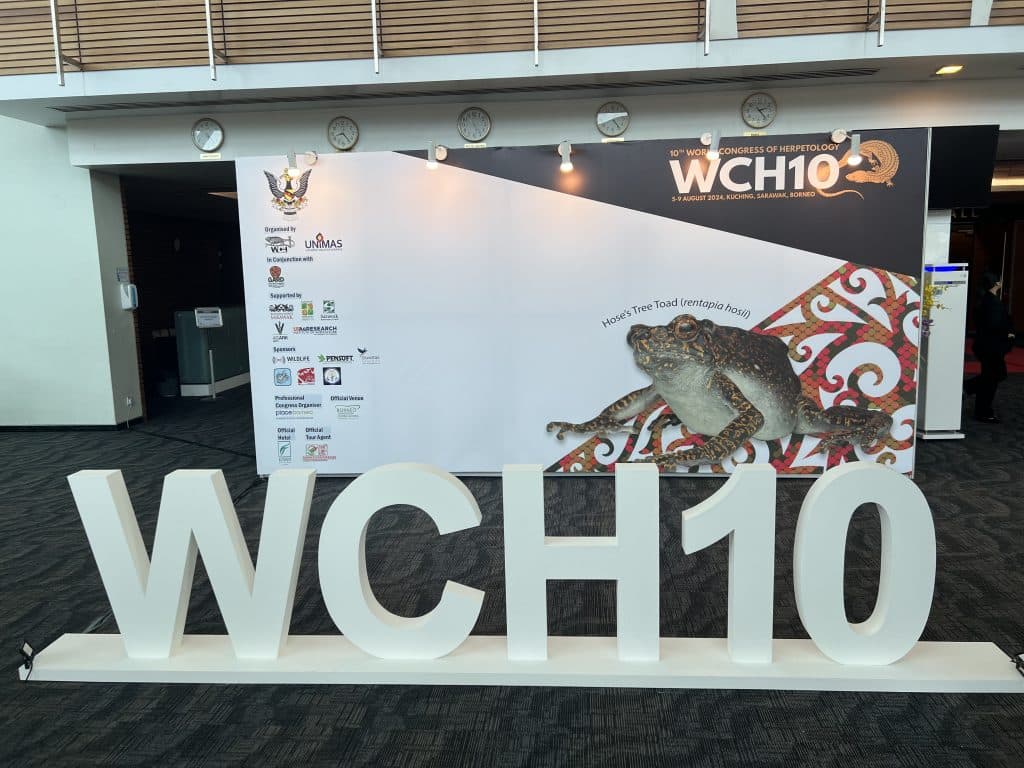

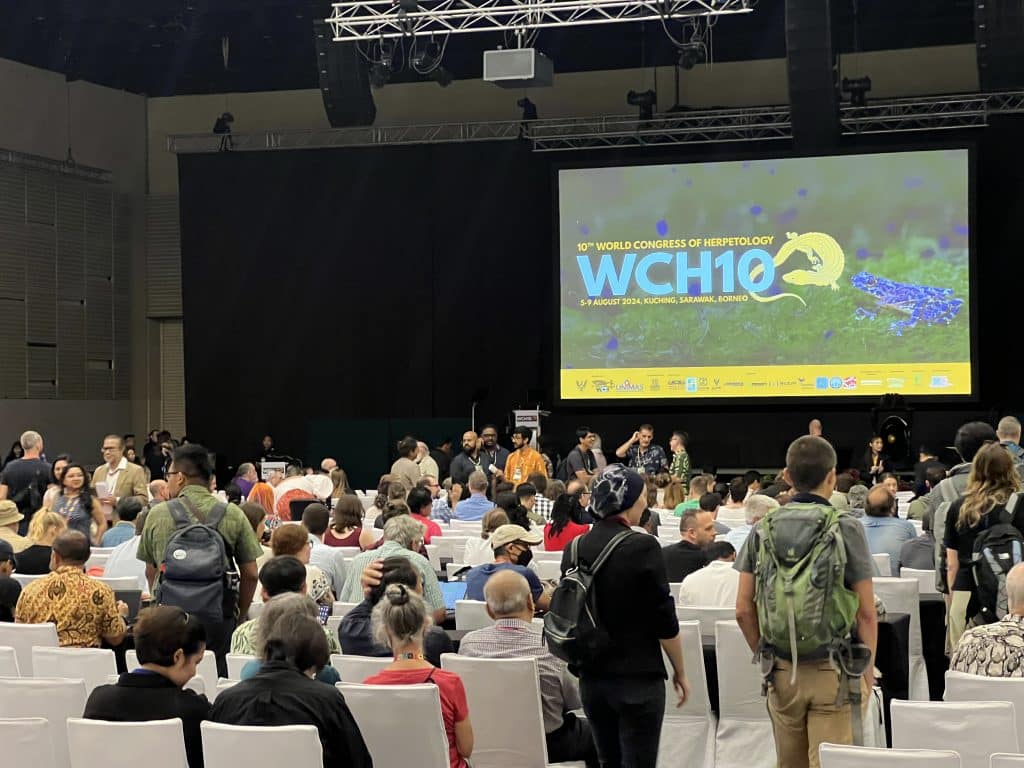













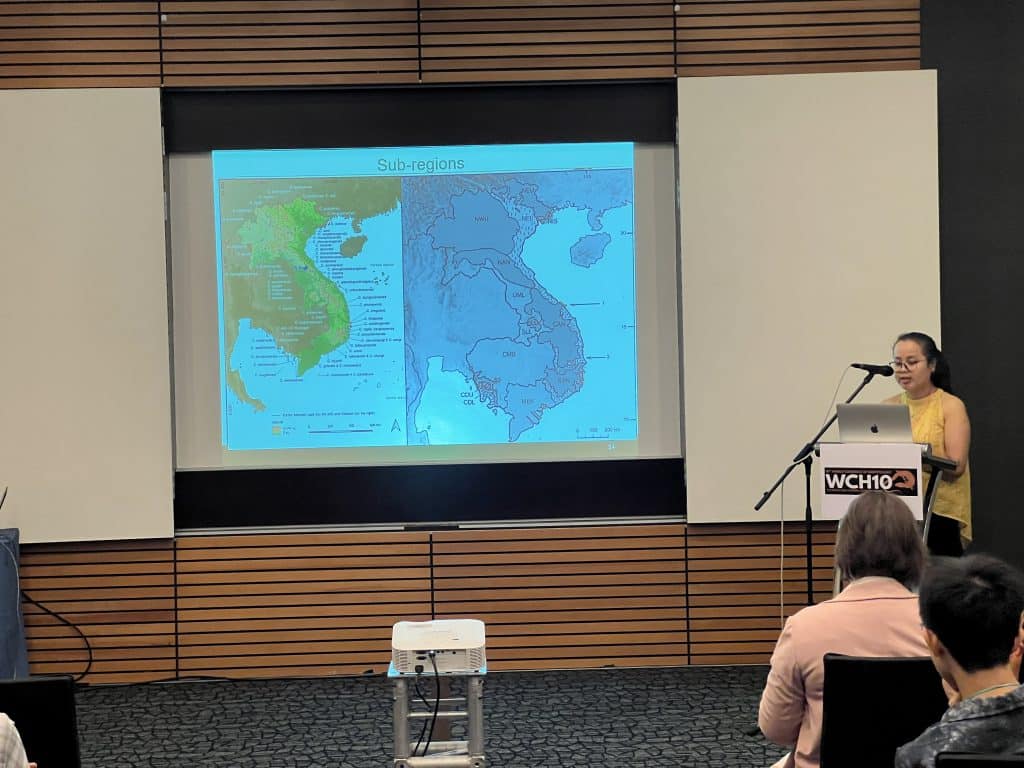


Our contributions in detail:
Auliya, M.: The Global Conservation Status of Varanus Merrem, 1820 – Overview of Threats and Uncertainties in the Assessment of Their Protection Status
In 2003, 58 Varanus species were known to science, today ca. 89 species are known. More than 10 subspecies now have full species rank and new species have been discovered. Currently, 74 species have been evaluated in the IUCN Red List, of which ca. three species require an update due to taxonomic changes, and others likely including new taxa. Among the 74 species, 12 have been assessed in threat categories (CR, EN, VU), two species as Near Threatened (NT), 10 species as Data Deficient (DD), and 50 species evaluated Least Concern (LC). Information on population trends does not necessarily match with Red List categories, e.g., species evaluated LC may have a decreasing population trend. Importantly, in 30 species the population trend is unknown, of which several have been evaluated LC. Year of assessment is crucial to evaluate a species’ current conservation status, in 10 species the year of assessment dates back ≥ 10 years. Analysis of threats indicated in the Red List clearly reveal numerous uncertainties. For almost no species it is possible to indicate the various combinations of threats and the contribution they make to overall declines; accordingly, further research and monitoring is recommended. Various species are utilized for consumption, traditional medicines, hides for the fashion leather industry and the pet trade, with the latter often not indicated in the Red List. Gradually, more space is being given to use and trade as a potential/actual threat, but its assessment as a possible cause of population declines often remains unconsidered. For many Hapturosaurus spp. for example there is a perpetual international demand; information on potential fragmentations of geographically wide-ranging species remain unmentioned, especially when these are well-established lucrative resources. More research is required to eliminate existing uncertainties to establish measures for improved conservation of the Varanidae in the short term.
Baral, S., and D. Rödder: Evaluating wetland policies for the conservation of Mugger Crocodile in Terai-Arc Landscape, Nepal using a spatially explicit population simulation model
Multiple ecosystem services provided by the freshwater ecosystems make them one of the most productive for humans. However, these ecosystems are threatened due to multiple human-induced factors, which have led to the complete or local extinction of many wetland-dependent species and threatening others equivalently. Nepal is no exception to this trend and has lost a significant proportion of healthy wetland ecosystems but only a few policy practices exist for their conservation. In this study, we evaluate the usefulness of these policies to support the conservation of a threatened crocodile the Mugger crocodile in the Terai Arc Landscape of Nepal using a spatially explicit individual-based population model. We define multiple scenarios based on the management recommended by these policies viz. wetland protection in protected areas only, forested areas, government-owned wetlands, and a complete protection of currently identified wetlands. We estimated multiple demographic and dispersal parameters using available literature from multiple species and ran a population simulation model in a freely available program RangeShifter 2.0 for 100 years. We found that the crocodile population persisted for 100 years in all the scenarios. The population at the end of the simulation was significantly higher in the scenario assuming total protection. Maximizing the conservation of wetlands increased the survival of dispersing individuals by creating multiple stepping stones for dispersal and greater availability of habitat patches to hold higher populations. We conclude that the current wetland conservation policies are enough to sustain the population but are not enough to ensure connectivity between the populations. Better protection of available wetland habitats will lead to increased population sizes but might also lead to increased contact with humans. Integrating possible conflict management and means to promote the gene flow of the population in wetland-related policies will promote co-existence in these wetlands.
Bhattacharya, S., M. Auliya and A. Koch: Case Study of Altering Community Perceptions of Monitor Lizards (Varanidae, Varanus spp.) among the Santhal Tribes of Birbhum, West Bengal, India
The “Santhals” are one of the numerous indigenous tribes of India inhabiting several parts of the central and eastern Indian states including West Bengal. Our case study has been conducted in five Santhal villages of the Birbhum district of West Bengal. In spite of the availability of modern food sources and medicines, the tribal communities still significantly utilize and exploit various local wildlife species, especially the Bengal monitor (Varanus bengalensis) and the Yellow monitor (V. flavescens). We explored and documented the utilization patterns, traditional beliefs and taboos related to these species, both of which are nationally protected under the Wildlife (Protection) Act of India, 1972. In addition, V. flavescens has been evaluated “Endangered” and V. bengalensis as “Near Threatened” in the IUCN Red List. Moreover, apart from the regular utilization patterns, the Santhals participate in annual hunting festivals, traditionally known as “Bandla Porob”. Semi-structured questionnaire surveys were conducted among the hunters of the tribal communities in five villages. The results provide several direct proofs of local people utilizing monitor lizards for medicines and food. Based on this specific evidence, we designed awareness workshops for the tribal villagers. The main objective of the workshops was to create a widespread perception among the villagers regarding the importance of biodiversity and its sustainable conservation, with a focus on monitor lizards that play a crucial role in their ecosystems.
Chuliver, M., C. Koch and A. Scanferla: Morphology and Ontogeny of Pelvic Girdle and Hind Limb of Thread Snakes (Serpentes: Leptotyphlopidae)
Threadsnakes (Leptotyphlopidae) retain pelvic and hindlimb elements despite of their limblessness. These minute structures can now be studied in detail thanks to novel techniques such as contrast-enhanced micro-CT. In this study, we provide detailed inter- and intraspecific comparisons of the anatomy of the pelvic girdle and hindlimb elements for thirteen species of leptotyphlopids, including ontogenetic and sexually dimorphic variation in Freiberg’s thread snake, Epictia australis. Leptotyphlopids show different degrees of development of their pelvic skeleton, as it might be formed by three elements (ilium, ischium, pubis) with a well-developed femur (Epictia, Leptotyphlops, Trilepida), one rod-like pelvic rudiment of unknown identity attached to a rounded element assigned to the femur (Tricheilostoma), or a single triradiate element (Myriopholis). Intraspecific variation is present in length or robustness of the individual elements, and asymmetries are found in those species having the largest degree of reduction of the elements. In Epictia australis, the ilium is long, posterodorsally directed and curved, its distal end is cartilaginous and can present two different forms. The ischium is posteriorly directed, rod-like, and its distal end is covered by a conical cartilage. The pubis is short, conical and extends anteriorly in opposition to the femur. The femur is the stoutest bone, it exhibits a thin cartilage covering its distal tip, and a rounded protuberance on its proximal region which is directly linked to a keratinized claw. As in other snakes such as boas and pythons, claws are present both in males and females, located anterolaterally to the cloacal region and slightly protruding between scales. This analysis provides new perspectives to discuss the functional and ecological value of pelvic and limb elements in snakes and, therefore, will shed light on relevant topics such as limb loss or vestigial organs as a source of morphological novelties in vertebrates.
Graboski, R., T. M. Cohen, C. Koch, A. M. Bauer and S. Meiri: Systematic and Taxonomic Survey of Israel’s Land Reptile Biodiversity – and a Blind Snake Example
Cryptic species have always posed a challenge for taxonomists. The advent of DNA sequencing has given biologists a new powerful tool for detecting and differentiating morphologically similar species. Yet, taxonomic studies are usually carried out piecemeal, and in many regions, such as most of the Middle East, they are almost nonexistent. We are conducting a rapid genetic survey of the entire reptilian fauna of Israel and examine genetic diversity within currently recognized species to identify potentially cryptic species and describe them. Fossorial snakes belonging to the Scolecophidia commonly show cryptic diversity. To test the status of the Israeli scolecophidian, the Long-nosed worm snake (Myriopholis macrorhyncha), we conducted the most comprehensive phylogenetic analysis of the M. macrorhyncha species complex. Three mitochondrial genes (12S, 16S, and cyt-b) and five nuclear genes (bdnf, cmos, rag1, nt3, and ame) were partially sequenced for 30 specimens belonging to eight species of the group (including three Israeli specimens). Sequences were aligned and a molecular tree was estimated by maximum likelihood (ML). Our tree for the genus shows five well-supported clades: 1) M. longicaudus; 2) “M. macrorhyncha” from Kenya, M. hamulirostris, M. rouxestevae, and M. boueti; 3) M. blandfordii, “M. macrorhyncha” from Ghana, M. adleri, and M. macrorhyncha from Oman and the UAE; 4) “M. macrorhyncha” from Iran and M. algeriensis; and 5) “M. macrorhyncha” from Israel, Jordan, and Turkey. We identify at least two lineages that represent new species and reveal a need for redefining the distributions of many species. Our molecular approach, based on an extensive taxon sampling, show that Myriopholis diversity has been largely underestimated. Our results highlight the importance of molecular data to understand Israeli reptile diversity.
Hofmann, S., D. Rödder, M. Matschiner, R. Masroor, C. B. Baniya, L. J. Borkin, S. Litvintchuk, V. Vershinin, D. Jablonski, L. Podsiadlowski, and J. Schmidt: Endemic amphibian lineages underscore the biogeographic significance of the Hindu Kush Himalaya region
The endemic spiny frogs of the genera Nanorana and Chrysopaa are key elements of the Hindu Kush and Himalayan amphibian fauna and may share a common biogeographic evolution, rendering them valuable tools for reconstructing the paleoenvironmental history of the Himalaya-Tibet-Orogen. However, little is known about the biogeography, systematics, and distribution of these taxa. We provide phylogenomic data and paleoclimatic niche models for Himalayan spiny frogs. The results strengthen support for a trans-Tibet dispersal of ancestral spiny frogs during the Paleogene and highlight the biogeographic importance of the Hindu Kush-Himalaya region.
Kaiser, H., and C. M. Kaiser: Finding Diagnostic Patterns in Morphologically Conservative New Guinea Groundsnakes (Genus Stegonotus): A Closer Look Reveals Undescribed Diversity
Our recent work on the radiation of groundsnakes, genus Stegonotus, has shown that throughout Wallacea and New Guinea the diversity of these snakes has been underestimated. With many populations falling into the category of “nondescript brown snake”, and with a limited availability of molecular data, we have been forced to rely on a rather exacting morphological approach in order to elucidate the taxonomy of the group. By tracing the nomenclature and type localities of species occurring on the island of New Guinea, we found that incorrect species names have previously been applied to two populations from north of the New Guinea Highlands, whose morphology and molecular affinities clearly indicate that they are distinct, unnamed species. In the southwest of New Guinea’s Bird’s Head Peninsula are two populations, whose morphological distinctiveness from Stegonotus ayamaru indicate that they, too, are unnamed species. Lastly, a preliminary survey of Batanta Island revealed the existence of a third species, in addition to S. iridis and S. derooijae, which is distinct in both coloration and scale counts. The presence of three species in the areas under discussion is unsurprising, given that historical collections document the presence of S. diehli, S. poechi, and S. dorsalis in a relatively small area of Madang Province, PNG. It therefore appears that behind the conservative morphology of these snakes is hidden an unrecognized and undocumented resource partitioning ability.
Koch, C: Diversity of Scolecophidian Snakes
Currently 474 scolecophidian snakes are recognized in five families: Anomalepidae, Leptotyphlopidae, Gerrhopilidae, Xenotyphlopidae, and Typhlopidae. In all scolecophidians strong selection associated with a fossorial lifestyle has led to cranial consolidation, miniaturization, and body elongation, resulting in worm-like habits – usually less than 30 cm in total length, and tiny skulls – often just a few millimeters long. Most scolecophidian species look superficially alike, and among all snakes, they are unsurpassed in difficulty of identification due to their low number of diagnostic characters and the difficulties in accurately illustrating and collecting morphological data due to their small sizes. Both, biologically and taxonomically, the scolecophidians are the least studied group of snakes. The presentation gives an insight into external and internal morphological features of Scolecophidia with a special focus on osteological findings. Furthermore, it provides information on the limited data known so far on the biology and some exciting facts about these fascinating reptiles.
Kupfer, A., Q. Martinez and C. Koch: A Brief Introduction to the Diversity of Subterranean Amphibians and Reptiles
Subterranean habitats are usually lightless, hypoxic and hypercapnic inhospitable environments with scarce food resources that lead to strong evolutionary constraints for organisms inhabiting them. Nevertheless, several amphibians and reptiles i.e., caecilian amphibians, fossorial anurans, amphisbaenians, scolecophidian snakes and many more independently evolved a subterranean lifestyle accompanied with diverse adaptations including elongated bodies, robust skulls, stronger forearms, limb reduction, reproductive modes or even a complete loss of the eyesight. However, due to the inaccessibility of the habitat and a lack of sampling methods the knowledge on the biology of burrowing herpetofauna has lacked far behind. The last symposium dedicated to the biology of subterranean herpetofauna i.e, “Quantifying the ecology of burrowing herpetofauna” held at the WCH5 in Stellenbosch, South Africa dates to 2005. Within nearly two decades much information on several aspects of the biology of fossorial amphibians and reptiles has accumulated. The symposium aims to summarise some of these diverse progresses but will also shine a light on the new developments of the research field.
Liz, A. V., D. Rödder, D. V. Gonçalves, G. Velo-Antón, M. J. Paúl, N. Drake, P. Breeze, P. Tarroso, P. Hopcroft, P.-A. Crochet, R. Godinho, S. B. Carvalho and J. C. Brito: Comparative Phylogeography Reveals Ancient Corridors, Refugia and Cradles of Genetic Diversity in Sahara-Sahel Vertebrates
In the Sahara, climatic oscillations between savannah and desert states for at least the last ten Million years left deep imprints on biodiversity patterns. Mountain and coastal areas have been postulated as ecological refugia and diversification centres, at least for the more mesic communities inhabiting the region, and a series of trans-Saharan green corridors connecting the Mediterranean and Afrotropics have also been suggested. However, these biogeographic hypotheses have only been based on a handful of species. Xeric taxa should present different patterns, but even less is known about these. Accordingly, this work seeks to map vertebrate diversity across the arid ecoregions of North Africa (the Sahara and Sahel) in order to consolidate and test biogeographic scenarios for the region since the Miocene. We used >8,500 geo-referenced DNA sequences and > 28,000 occurrence points from 104 vertebrates (reptiles, mammals, amphibians, and birds) to map intra-specific genetic diversity (ISD) and connectivity, and model past species habitat shifts, considering climate, hydrology, vegetation, and substrate information. By analysing the concordance between genetic and ecology-based inferences, we attempted to identify diversity hotspots, refugia and corridors, and compare spatial patterns among mesic and xeric species. For xeric taxa, the northern Sahara, together with the southwestern Sahel, was identified as the main ISD hotspot. Ecological results supported northern Sahara refugia, which extended southwards. For mesic taxa, ISD hotspots covered most Saharan highlands, the Nile Valley, coastal areas, and the Niger Delta. Refugia were mostly concordant with ISD hotspots. Ecological xeric connectivity was overall widespread, while genetic corridors primarily included the Atlantic Sahara, the Nile Valley outskirts, and the eastern Sahel. Mesic corridors included the Atlantic coast and, to a greater extent, the Central Sahara highlands. The patterns recovered by this comprehensive study should help understand the historical biogeography of the largest warm desert on Earth.
O’Shea, M., and H. Kaiser: Introducing the Secretive Serpents of Paradise, the Endemic New Guinea Elapid Genus Toxicocalamus (Elapidae: Hydrophiinae)
Toxicocalamus is a genus of rarely seen, vermivorous, oviparous, hydrophiine elapids, endemic to the island of New Guinea and its satellite islands and archipelagos. A century after George Albert Boulenger named the genus in 1896, Toxicocalamus contained 10 taxa (nine species and one subspecies). However, since 2009, resurgent interest in the genus has elevated this number to 24 species, of which 13 have been examined using molecular data. Toxicocalamus is now the largest, non-marine, alethinophidian snake genus in the Australasian-Melanesian region, and it is set to become even larger as further species will be described in the near future. Yet Toxicocalamus also remains a relatively understudied genus, with dietary preferences and reproductive status largely obtained from post-mortem examination. Toxicocalamus species are almost unique amongst terrestrial Papuan elapids in lacking a temporolabial scale between the penultimate and ultimate supralabials, along with only Pseudonaja. Several members of Toxicocalamus are relatively stout-bodied and quite sizeable (up to 1.0 m in total length in two species), there is also a number of extremely slender “bootlace” species with especially short tails, that may be more fossorial or semi-fossorial in habit. The stouter species exhibit typical colubrid-elapid head scutation; 15-15-15 dorsal scale rows; six supralabials; the cloacal covering consisting of two scales; and paired subcaudals, whereas the “bootlaces” display a great deal of variation. Dorsal scales are arranged in 13-13- 13, 15-15-15, or 17-17-17 rows; subcaudals can be paired or single; the cloacal covering can be formed from one or two scales; the supralabials can number from 4–6, and the species exhibit a diverse array of head scute fusions including fused inteasal + prefrontal; preocular + prefrontal; inteasal + preocular + prefrontal; frontal + supraoculars; supraocular + postocular; and supralabials + temporals, which provide valuable clues that aid in the identification of a specimen in hand.
O’Shea, M., F. Kraus and H. Kaiser: Hidden Diversity and Natural History of the Secretive New Guinean Worm-eating Snakes, Genus Toxicocalamus (Elapidae: Hydrophiinae), Revisited
Toxicocalamus is an elapid genus represented by 526 specimens in thirty collections worldwide. It is a genus of diual but secretive, terrestrial, or fossorial, oviparous, vermivorous snakes, endemic to the island of New Guinea and its satellite islands. These snakes inhabit rainforest, hill and pre-montane forests, or montane grasslands, but one species is especially common in earthworm-rich highland garden systems. Most species are relatively small (< 600 mm in SVL), but two species approach or exceed 1.0 m total length. Many species exhibit distinctive head-scute fusion arrangements that greatly aid in their identification. The genus was erected in 1896 by George Albert Boulenger based on T. longissimus from Muyua (Woodlark) Island, a satellite of New Guinea off the southeast coast of New Guinea. During the remainder of the 19th Century additional species were described, both in Toxicocalamus but also in three other genera (Apistocalamus, Pseudapistocalamus, Ultrocalamus) that were later reduced to subgenera within Toxicocalamus. By the end of the 1960s, Toxicocalamus comprised nine species, and this number remained constant for forty years until a new generation of herpetologists started to investigate the genus. Since 2009 a further twelve species have been described and three have been resurrected from synonymy, bringing the current total to 24 species, making Toxicocalamus the most diverse terrestrial alethinophidian snake genus east of the Wallace Line and descriptions of further new species are currently in preparation.
Parmar, D. S., and H. Kaiser: Sparks among the snakes? A potential genetic explanation for unusual color morphs in Daboia russelii (Shaw & Nodde, 1797) and Lycodon aulicus (Linnaeus, 1758) from India
Along with the well-documented color polymorphisms of various snakes bred in the pet trade, more and more reports of color aberrations in snakes encountered in the wild are being published. This is likely a consequence of the increased activities of snake rescue teams around the globe and the resultant higher level of snake awareness among local human populations. We found unusual color morphs in two vipers, Daboia russelii, and a wolfsnake, Lycodon aulicus, in India. These snakes display a strongly abnormal coloration, with near-leucistic and unpatterned vipers and a nearly unpatterned wolfsnake. Yet each of these snakes possesses striking vertebral lines. The uniformly brown L. aulicus has a normal neck band but the expected transverse banding pattern is missing. The coloration of the vertebral scale row and its two adjacent scales creates a longitudinal pattern of a dark brown vertebral line framed in a cream color, beginning 11 scales beyond the parietals and extending two thirds the body length. In contrast, the line pattern in the vipers begins at the neck and consists of three un- or lightly pigmented scales along the vertebral line, framed by a single row of dark scales on either side and extending more faintly onto the posterior part of the body. While the primarily white viper from Gujarat retains the dark lateral rings that typically offset different shades of brown in normal phenotypes, the body of the subadult from Goa is a patternless light brown. The patterning is strongly reminiscent of a genetic modification in the pathway controlling chromatophore development that has been called spark/spark in ball pythons (Python regius). Detailed genetic studies of this phenomenon would be ideal, but the uniqueness of these color aberrations in these two species makes such work impractical – but it reveals nature as a sometimes-eccentric painter of lines.
Reilly, S. B., B. R. Karin, U. Arifin, H. Kaiser, A. L. Stubbs, E. Arida, A. Hamidy, D. T. Iskandar and J. A. McGuire: Phylogenomics of Lesser Sunda Emerald Tree Skinks (Lamprolepis smaragdina) Uncovers a Broad Range Expansion Followed by Low Gene Flow
The Emerald Tree Skink, Lamprolepis smaragdina, is an arboreal lizard that is well adapted to over-water dispersal and is found throughout Wallacea and the western Pacific islands. These lizards are found on every major island in the Lesser Sundas where they exhibit one or more of three distinct color patterns: a green morph, a brown morph, and a half-green half-brown morph. Given this species’ propensity to successfully disperse from island to island, we expected to find moderate levels of gene flow and low genetic divergence between Lesser Sunda island populations. We used both mitochondrial (1426 bp for 174 lizards) and exoncapture (1411 sequence loci for 104 lizards) datasets to reconstruct phylogenetic relationships and estimate divergence times and levels of migration for L. smaragdina populations across 12 Lesser Sunda islands. The results support a scenario where the Lesser Sundas assemblage diverged from the Peleng Island (off eastern Sulawesi) population ~1.5 Ma with subsequent dispersal events within the Lesser Sundas occurring between 1–0.4 Ma. Biogeographical model testing supports a scenario where many dispersal events occur parallel to or against major longterm oceanic currents of the “Indonesian Throughflow”. While some of the mito-nuclear discordances indicate secondary dispersal events have occurred between established populations, genomic estimates of migration show near total genetic isolation of all populations. This implies that either population sizes are too large to detect the genes of more recent migration events, or that recent migrants are unable to successfully reproduce with the established population.
Riedel, J., K. Eisele, Y. Ecker, T. Higham, J. Wu, Q. H. Do, T. Q. Nguyen, C. G. Meneses, R. M. Brown, L. L. Grismer, T. Ziegler, A. P. Russell, and D. Rödder: Evolution of incipient toepads in a radiation of ecologically diverse geckos
Adhesive toepads have evolved repeatedly in a variety of clades to promote attachment to inclined surfaces in climbing species. Among amniotes, geckos are the most thoroughly studied with regard to their adhesive toepads. Even so, the evolutionary origin of these complex structures is still elusive, this being partially due to the scarcity of studies on species with incipiently developed toepad morphologies. One suggested model for the presence of incipient toepads are the bent-toed Geckos (Genus Cyrtodactylus), an ecologically diverse radiation, the climbing members of which possess enlarged subdigital scales. It is known that a few such species carry spatulated setae as microstructures on these scales. Given this, we explore the evolution of incipient toepad morphology in Cyrtodactylus species from different microhabitats (ecotypes) in relation to habitat use (terrestrial, arboreal, rock-dwelling and generalists) to unravel how and under which ecological circumstances adhesive toepads evolved. We measured size-corrected subdigital scale area, examined subdigital scale shape using 2D geometric morphometrics, and subdigital microstructures using scanning electron microscopy (SEM). We reconstructed the evolution of these traits and tested whether species occupying different microhabitats differed in their subdigital scale morphology. We found that both arboreal and rock-dwelling species had relatively larger subdigital scale areas, but partly differed in scale shape. Microstructures also differed among ecotypes with spatulated setae being more prevalent in climbing species.
Riedel, J., L. L. Grismer, T. Higham, J. Wu, Q. H. Do, T. Q. Nguyen, C. G. Meneses, R. M. Brown, P. D. Campbell, T. Ziegler, A. P. Russell and D. Rödder: Ecomorphology of the Locomotor Apparatus in the Genus Cyrtodactylus (Gekkota, Squamata)
Adaptive radiations garner considerable interest from evolutionary biologists. Lizard radiations diversifying along structural niche space often exhibit distinct changes in body and limb proportions. One prediction is that terrestrial species inhabiting open habitats will have relatively longer hindlimbs, associated with faster running speeds, while scansorial species will have relatively shorter limbs to keep the centre of mass closer to the substratum. Alternatively, terrestrial species in densely vegetated habitats could benefit from relatively shorter limbs to prevent entanglement with more frequently encountered obstacles, whereas scansorial species could benefit from longer limbs promoting greater limb spans and static stability. Cyrtodactylus, an ecologically diverse gekkonid genus, includes numerous specialists with narrow structural niches, but the degree of morphological diversification exhibited by these specialists is largely unknown. We investigated associations between locomotor morphology and structural microhabitat use in Cyrtodactylus to test if either of the opposing predictions can be corroborated for this radiation. We measured body length and relative limb dimensions of 87 species, covering multiple independent transitions among structural microhabitat preferences. Using these data, we reconstructed the phylomorphospace and tested for associations between structural microhabitat niche and limb morphology. We found strong separation between structural niche groups in accordance with the second hypothesis, although overlap is evident among functionally related niches such as those of granite and karst specialists.
Rödder, D., J. Secondi, J. Altenhofen and G. Vimercati; The Relative Influence of Habitat Availability, Landscape Configuration and Spatial Sorting on Population Expansion in Xenopus laevis: A Simulation Test
Population expansion into new areas is a common phenomenon driven by changes in ecological conditions. It also increasingly results from human-assisted introduction of propagules into novel environments, which leads species to spread into areas where they did not evolve and cause various ecological and socio-economic impacts. Spatial sorting (the enhanced dispersal capacity in expanding populations over time) and landscape configuration are two factors that largely influence the way organisms move across a landscape and reach locations to complete their life cycle. While both factors have been frequently studied independently, their relative influence to modulate the spread rate of expanding populations has been significantly unexplored. We simulated the spread of an invasive amphibian, Xenopus laevis, in various landscapes of its colonized ranges and surroundings in western France. By using the software UNICOR, we ran colonization simulations on 30 x 30 km cells of an experimentally parameterized resistance layer at three settings of spatial sorting. Results show that habitat availability (ponds density) and spatial sorting positively affected the rate of population expansion in the cells and interacted: higher spatial sorting and pond density increased the invaded area, number of colonized ponds and maximal traveled distance per time unit. In contrast, none of the four landscape configuration metrics improved the models, suggesting that this factor has limited influence on population expansion. The effect of spatial sorting on population spread was enhanced by pond density but not by landscape configuration. These results may partly reflect the high density of ponds and the relative contribution of landscape configuration may be reevaluated in different landscape types. Nevertheless, these highlight the importance to consider jointly habitat availability and spatial sorting in predictive modeling of the spread process in expanding populations, such as those that characterize many alien species.
Tan, W. C., V. Vitalis, J. Sikuim, D. Rödder, M.-O. Rödel and S. Asad: High Freshwater Turtle Occupancy in a Sustainably Managed Tropical Forest, Borneo
Despite suffering dramatic declines due to habitat loss and overexploitation, tortoises and freshwater turtles, particularly those in Southeast Asia remain largely understudied. This region is not only a diversity hotspot, but also the centre of an international turtle trade and increasing anthropogenic pressures. In the face of these threats, the utility of sustainable forest management for the conservation of threatened freshwater turtle populations is unknown. This study examines the impact of Reduced Impact Logging, a sustainable forestry method, on two freshwater turtle species. We examined the detectability and habitat relationships of a threatened hard-shelled turtle, Notochelys platynota and a non-threatened soft-shelled turtle, Dogania subplana within a commercial forest reserve in Sabah, Malaysian Borneo. Using single-species occupancy models, we identified covariates associated with the detection and occupancy probabilities of the species across a post-harvest recovery gradient (1–21 years since logging). Results for D. subplana were inconclusive. In contrast, we found a significant negative association between monthly rainfall and N. platynota detectability. The occupancy probability of N. platynota was positively associated with greater distance from logging roads and higher stream flow accumulation. Occupancy probability for N. platynota and D. subplana was relatively high throughout the reserve. These results, suggest that forests managed sustainably, i.e. using RIL methods, could serve as invaluable conservation areas for imperiled freshwater turtle species in the region.


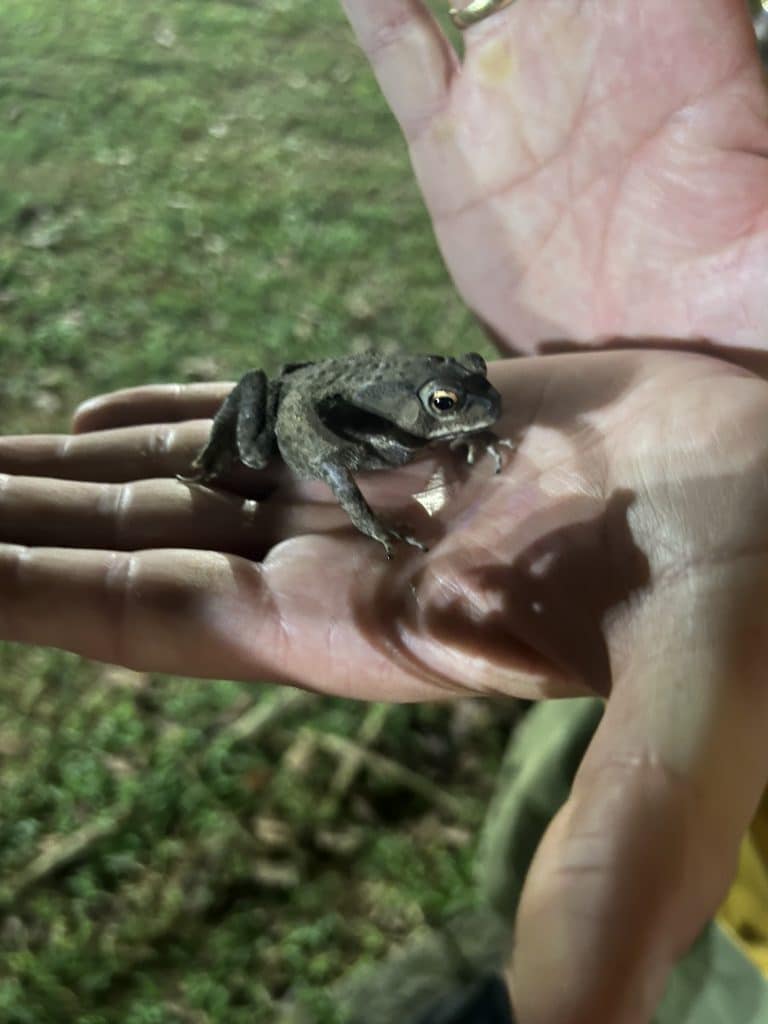








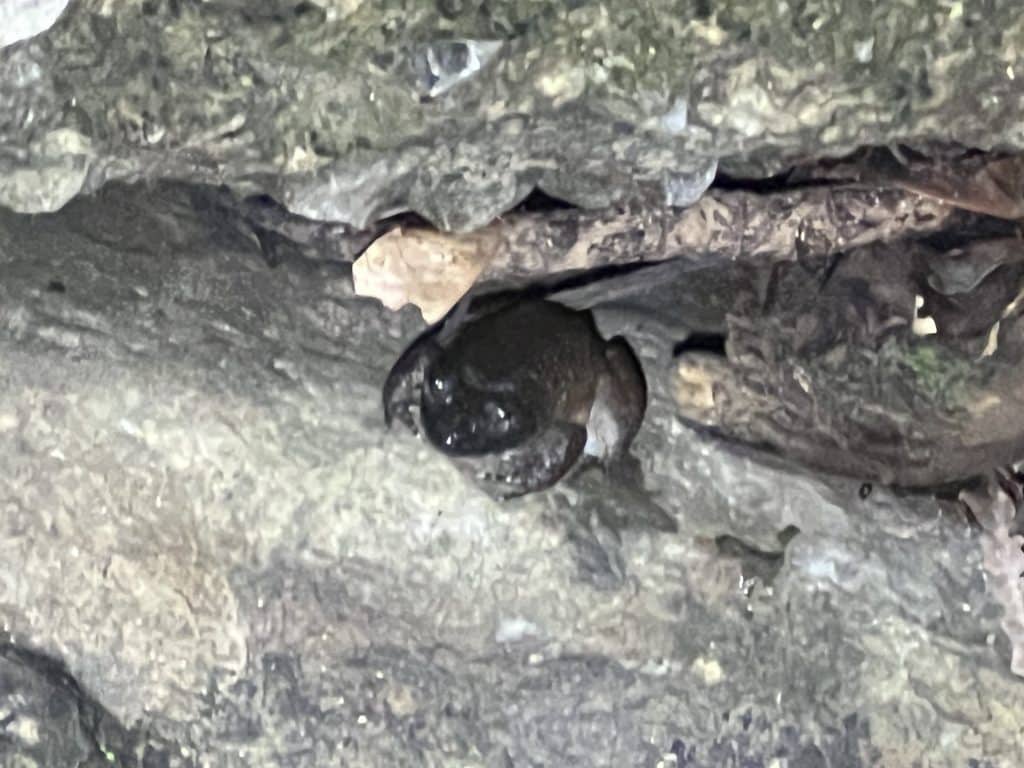

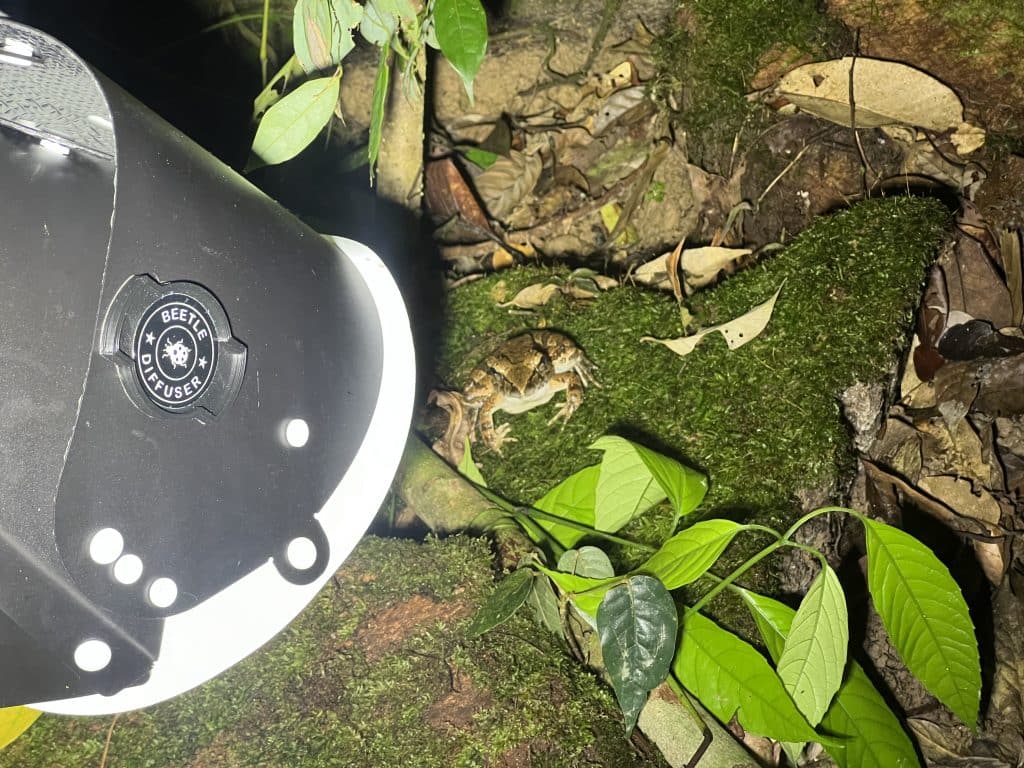
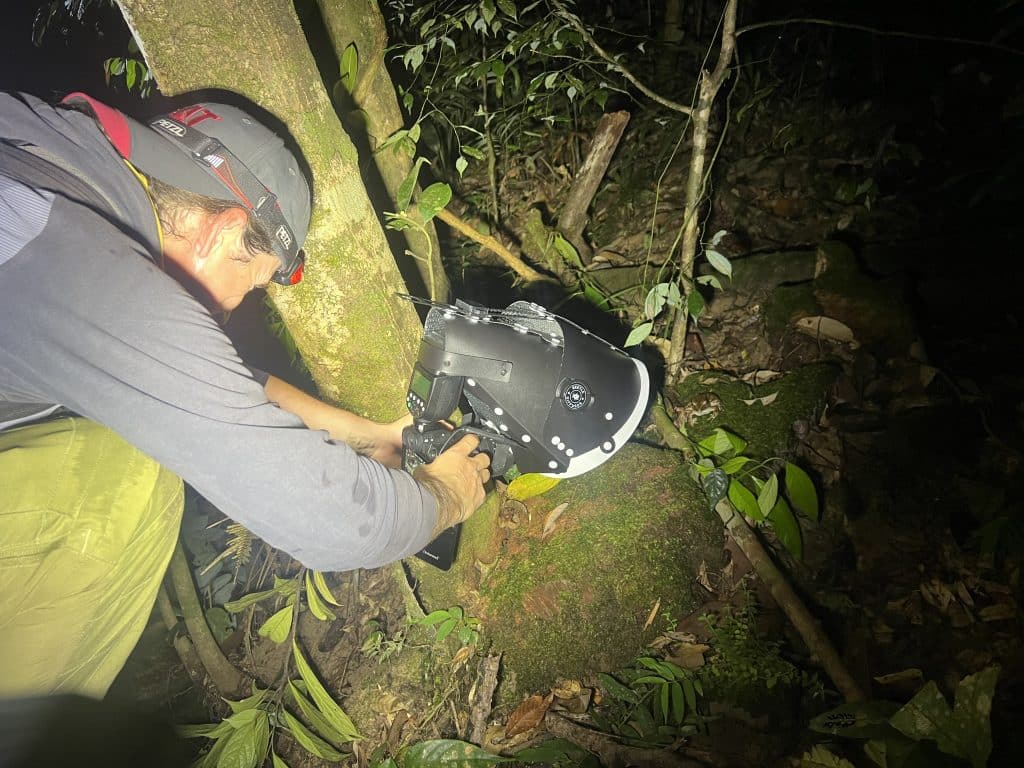









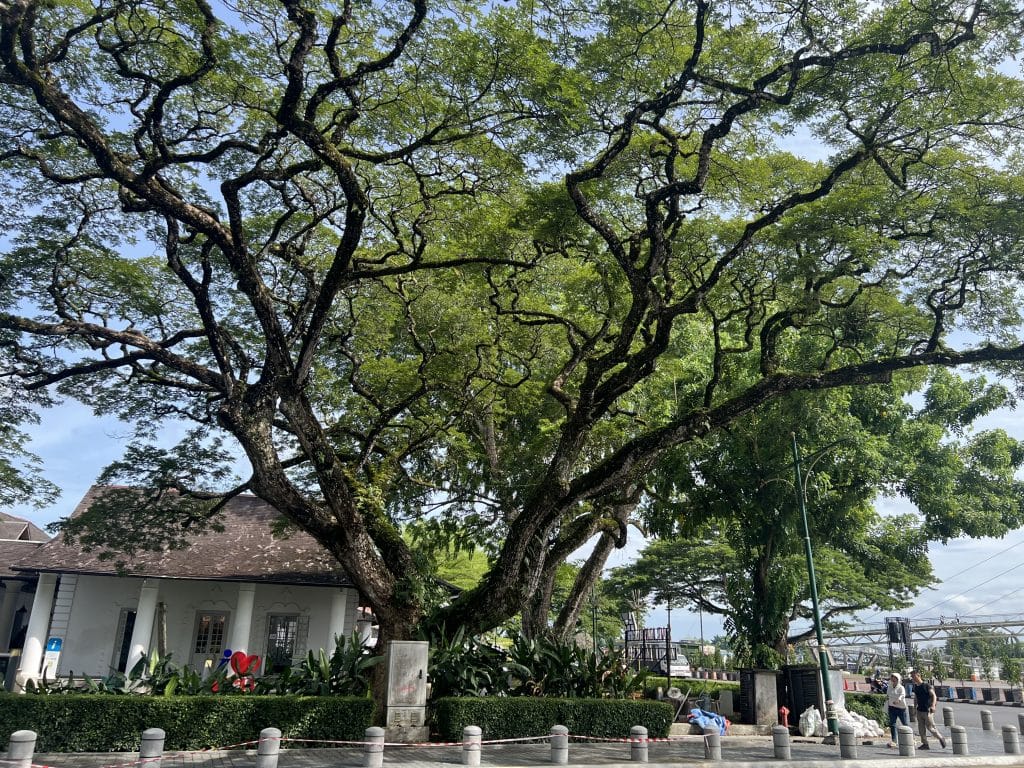


PhD defense of Philipp Ginal
Philipp Ginal has just very successfully defended his PhD thesis!
“Invasion biology of amphibians and reptiles: From observations to predictive spatial models”
His thesis entitled “Invasion biology of amphibians and reptiles: From observations to predictive spatial models” comprises six publications. Overall, his thesis is broadly folded, and comprises several target species across different taxonomic groups (i.e., anurans, urodeles, squamates), scales (i.e., local, regional, macro-ecological landscapes), and methodological approaches (i.e., population size estimation, connectivity modeling, correlative and mechanistic species distribution modeling, mechanistic quantification of activity time budgets). The focus of my thesis relies on the methodological approaches and therefore, the red line here starts with relatively simple models and ends with a novel, complex mechanistic approach.
Furthermore, three publications consider the African Clawed Frog, Xenopus laevis (Daudin, 1802), which is among the most invasive amphibian species in the world.
Two further publications focus on the Oriental Garden Lizard, Calotes versicolor (Daudin, 1802) complex, a wide-spread but neglected invader with potential negative impacts, and the Italian Cave Salamander, Speleomantes italicus (Dunn, 1923), which is non-native but locally very restricted with no known negative impacts yet. Another publication considers the invasive fungal disease Batrachochytrium salamandrivorans Martel et al. 2013 (Bsal), which has substantial negative impacts on macro-ecological scales, and one of its host species, the European Fire Salamander, Salamandra salamandra (Linnaeus, 1758).
These papers are already published and included in the thesis:
Ginal, P., N. Kruger, C. Wagener, L. Araspin, M. Mokhatla, J. Secondi, A. Herrel, J. Measey, and D. Rödder. 2023. More time for aliens? Performance shifts lead to increased activity time budgets propelling invasion success. Biological Invasions 25: 267–283. (PDF)
Ginal, P., W. C. Tan, and D. Rödder. 2022. Invasive risk assessment and expansion of the realized niche of the Calotes versicolor species complex (Daudin, 1802). Frontiers of Biogeography 14.3, e54299. (PDF)
Ginal, P., M. Mokhatla, N. Kruger, J. Secondi, A. Herrel, J. Measey, and D. Rödder. 2021. Ecophysiological models for global invaders: Is Europe a big playground for the African clawed frog? Journal of Experimental Zoology – Part A: Ecological and Integrative Physiology 2020: 158-172. (PDF)
Ginal, P. C.-H. Loske, T. Hörren and D. Rödder. 2021. Cave salamanders (Speleomantes spp.) in Germany: tentative species identification, estimation of population size and first insights into an introduced salamander. Herpetology Notes 14: 815-822. (PDF)
Ginal, P., F. D. Moreira, R. Marques, R. Rebelo, and D. Rödder. 2021. Predicting terrestrial dispersal corridors of the invasive African clawed frog Xenopus laevis in Portugal. NeoBiota 64: 103–118. (PDF)
21st European Conference of Herpetology in Belgrad, Serbia
Our group joined the 21st European Conference of Herpetology in Belgrad, Serbia, where our Herpetologists from the LIB, Musem Koenig were very active. We presented five talks and posters! The conference was awesome and the organizers did a very good job. Thank you very much! Here are some impressions and the abstracts.














Oral presentation
More time for aliens? Performance shifts lead to increased activity time budgets propelling invasion success
Ginal P.1,*, Kruger N.2,3, Wagener C.2,4, Araspin L.2,5, Mokhatla M.2,6, Secondi J.3,7,
Herrel A.8, Measey J.2, Rödder, D.1
1Zoologisches Forschungsmuseum Alexander Koenig (LIB), Bonn, Germany
2Centre for Invasion Biology, Department of Botany and Zoology, Stellenbosch University, Stellenbosch, South Africa
3Univ. Lyon, Université Claude Bernard Lyon 1, CNRS, ENTPE, UMR 5023 LEHNA, Villeurbanne, France
4Department of Zoology, University of Oxford, UK
5UMR 7179 C.N.RS/M.N.H.N., Département Adaptations du Vivant, Bâtiment d’Anatomie Comparée, Paris, France
6Department of Zoology and Entomology, University of Pretoria, Private Bag x20, Pretoria, Rondevlei Scientific Services, Garden Route National Park, South African National Parks, Sedgefield, South Africa
7Faculté des Sciences, Université d’’Angers, Angers, France
8UMR 7179 C.N.R.S/M.N.H.N., Département Adaptations du Vivant, Bâtim’ent d’Anatomie Comparée, Paris, France
*Corresponding author (e-mail): Philipp Ginal (philipp.ginal@gmx.de)
In the Grinnellian niche concept, the realized niche and potential distribution is characterized as an interplay among the fundamental niche, biotic interactions and geographic accessibility. Climate is one of the main drivers for this concept and is essential to predict a taxon’s distribution. Mechanistic approaches can be useful tools, which use fitness-related aspects like locomotor performance and critical thermal limits to predict the potential distribution of an organism. These mechanistic approaches allow the inclusion key ecological processes like local adaptation and can account for thermal performance traits of different life-history stages. The African Clawed Frog, Xenopus laevis, is a highly invasive species occurring on five continents. The French population is of special interest due to an ongoing expansion for 40 years and a broad base of knowledge. We hypothesize that the French population exhibit increased in activity time in the invasive European range that could be devoted to fitness-relevant activity and (2) tadpoles may have less activity time available than adult frogs from the same range. We investigate how thermal performance traits translate into activity time budgets and how local adaptation and differences in the thermal responses of life-history stages may boost the European Xenopus invasion. We use a mechanistic approach based on generalized additive mixed models (GAMMs), where thermal performance curves were used to predict the hours of activity and to compare the potential activity time budgets for two life-history stages of native and invasive populations. Our results show that adult French frogs have more activity time available in Europe than those in South African frogs, which might be an advantage in searching for prey or escaping from predators. However, French tadpoles do not have more activity time in Europe compared to the native South African populations indicating that tadpoles do not suffer the same strong selective pressure as adult frogs.

Oral presentation
Ecomorphology of the locomotor apparatus of the genus Cyrtodactylus (Gekkota, Squamata)
Riedel J.1,2,*, Higham T.3, Grismer L.4, Russell A.5, Reinhold K.2, Rödder D.1
1Museum Koenig Bonn – Leibniz Institute for the Analysis of Biodiversity Change, Bonn, Germany
2Department of Evolutionary Biology, Bielefeld University, Bielefeld, Germany
3Department of Evolution, Ecology, and Organismal Biology, University of California, Riverside, CA, USA
4Department of Biology, La Sierra University, Riverside, CA, USA
5Department of Biological Science, University of Calgary, Calgary, Alberta, Canada
*Corresponding author (e-mail): Jendrian Riedel (j.riedel@leibniz.lib.de)
Adaptive radiations, clades of closely related species diversified along one or more morphological and/or ecological niche axes, garner considerable interest from evolutionary biologists. Lizard radiations diversifying along spatial niche space are hypothesised to exhibit distinct changes in body length and relative limb dimensions. One hypothesis predicts that cursorial species have relatively longer hind limbs associated with faster running speeds and relatively shorter forelimbs preventing the latter from interfering with hind limb stride frequency. Accordingly, scansorial species are expected to have relatively shorter limbs, with the fore and hind extremities of more equal length, to promote the maintenance of their center of gravity closer to the substratum. Alternatively, terrestrial species in closed habitats could benefit from relatively shorter limbs because these may reduce their entanglement with more frequently encountered obstacles, whereas scansorial species could benefit from longer limbs which would result in greater limb spans and static stability. Cyrtodactylus is a speciose and ecologically diverse gekkonid genus. From generalist ancestors this clade has repeatedly produced specialists with narrow spatial niches, such as the occupancy of karst formations, caves, granite boulders, and different strata within the arboreal niche. For cave specialists, distinct morphological changes are associated with niche occupancy. The degree of morphological diversification exhibited by the other habitat specialists remains unknown, however. We investigated whether associations exist between limb dimensions and microhabitat use in this genus, to test if either of the opposing hypotheses can be confirmed for this successful radiation. To do so we measured body length and relative limb dimensions in a large sample, including all major lineages, reconstructed the phylomorphospace occupied by the species and tested for associations between spatial niche and limb morphology. We found strong separation between spatial niche groups, although overlap exists particularly among functionally related niches such as those of granite and karst specialists.

Oral presentation
Bite or run? Ecomorphological relationship in African agamas
Tan N.W.C.1,*, Measey J.2, Vanhooydonck B.3, Herrel A.4
1Herpetology Section, LIB, Museum Koenig, Bonn, Germany
2Centre for Invasion Biology, Department of Botany and Zoology, Stellenbosch University, Stellenbosch, South Africa
3Department of Biology, University of Antwerp, Antwerpen, Belgium
4Département Adaptations du Vivant, UMR 7179 C.N.R.S/M.N.H.N., Bâtiment d’Anatomie Comparée, Paris, France
*Corresponding author (e-mail): Nicholas Wei Cheng Tan (n.tan@leibniz-zfmk.de)
Understanding the relationships between form and function can help us to understand the evolution of phenotypic diversity in different ecological contexts. Many animals display morphological and behavioural adaptations to the habitats in which they live and the resources they exploit. Whole-organism performance traits such as bite force and locomotion are ecologically relevant as they reflect the ability of an organism to include a wider diversity, different or differently sized prey, to escape from predators, or to defend territories. Here, we investigate ecomorphological relationships between diet, morphology, bite force and locomotor performance (sprint speed and endurance) in six species of South African agamids from three habitat types (ground-dwelling, rock-dwelling, and arboreal). Diet analyses showed that ants are a major food source, alongside with active prey such as beetles, wasps and flies. Body and head size are not directly related to diet, although greater in-levers for jaw closing (positively related to bite force) are associated to an increase of hard prey in the diet. Rock-dwelling species have a relatively flatter head than other species, possibly as an adaptation for crevice use. However, even when correcting for jaw length and jaw out-lever length, rock-dwelling species bite harder than ground-dwelling species. Further, endurance capacity of these lizards is correlated with hind limb and toe lengths. Interestingly, however, we demonstrate trade-offs in performance where specialisation towards speed comes at the detriment of endurance. Arboreal species have longer hind limbs, and higher exertion capacity and mean speed. However, for a given hind limb length, they appear to be slower than the other habitat specialists. In sum, our study illustrates the role of morphology in driving functional changes and how habitat use impacts morphology and locomotor performance but not bite force.

Oral presentation
Spatiotemporal patterns of habitat use by the sand lizard (Lacerta agilis Linnaeus, 1758): Effects of climatic seasonality?
Schmitz L.M.1, Clement V.F.1, Edanackaparampil J.1, Ginal P.1, Schluckebier R.1,
Rödder D.1,*
1LIB, Museum Koenig Bonn, Leibniz Institute for the Analysis of Biodiversity Change, Bonn, Germany
*Corresponding author (e-mail): Dennis Rödder (d.roedder@leibniz-lib.de)
The distribution and occurrence of a species in its habitat is inevitably linked with its ecology. To successfully monitor and protect species, it is important to investigate which species-specific factors influence its interactions with the environment. In this study, we focus on patterns in habitat use of the sand lizard (Lacerta agilis). Seasonal as well as sex and age dependent habitat use differences were reported from the species’ range edges. To verify such trends in the core area of its distribution, we analyzed the habitat factors weather, microclimate, microhabitat structures and time dependence, which may have an impact on the behavior of the sand lizard. Using generalized linear models, hypervolumes, density estimations and Chi-squared tests, we found that the movement patterns of the individuals can neither be described by time differences, climatic conditions, or habitat composition, nor do they show habitat or weather-related differences of movement among sexes or age. Here we show that in the case of a population from the core distribution area at the Dellbrücker Heide (Germany), habitat use solely is influenced to a low degree by differences related to ontogeny of the sand lizards and does not depend on any of the other evaluated factors. These results from the core distribution area of the sand lizard show an enormous contrast to findings of populations from peripheral distribution areas, i.e. the United Kingdom, Latvia, Romania, Bulgaria, and the Pyrenees. This implies that seasonal habitats shifts are more extreme at the range edges of L. agilis to compensate deteriorating habitat conditions than in the periphery.

Plenary lecture
History of herpetological research on the Balkan Peninsula
Böhme W.1,*
1Leibniz Institute for the analysis of biodiversity change (LIB) – Museum Koenig, Adenauerallee, Bonn, Germany
*Corresponding author (e-mail): Wolfgang Böhme (w.boehme@leibniz-lib.de)
Southern Europe consists mainly of three large and separate peninsulas shaping the northern coastline of the Mediterranean Sea. Of these, the Iberian peninsula in the west harbours two countries, viz. Portugal and Spain, while the central Apenninian peninsula is made up by just one country, viz. Italy. The Balkan peninsula, in contrast, consists of significantly more countries, including independent states established upon the breakup of former Yugoslavia, then Albania, Bulgaria and Greece. Geographically, as defined by the famous Serbian geographer Jovan Cvijić, also the south of Romania and the European part of Turkey („Turkish Thrace“) have to be added. This historically induced multinational cultural diversity had also great influence on the history of science, including herpetology. The global birthplace and also the name-provider of the term herpetology was Greece and its language, where for instance Aristotle (384-322 BC) wrote an astonishingly exact description of the chameleon while the role of snakes was more a mythological one, nonetheless influential for the entire realm of the Greek-Roman antiquity. But since the origin of modern herpetology by the fundamental work of Carolus Linnaeus, mostly researchers from more northern parts of Europe started to study Balkan herpetology. The lecture will review the main contributors to the herpetology of the Balkan peninsula. They will be discussed countrywise, according to the contemporary geographic delimitations. A focus is laid on the remarkable shift from initially mostly foreign researchers towards autochthonous herpetologists taking care by themselves for the exploration of their respective countries. An overview of the zoogeographical importance of Balkan amphibians and reptiles is given, followed by a summary of important endemic species living in this herpetological diversity hotspot.

Poster presentation
Microhabitat specific performance of the chytrid fungus Batrachochytrium salamandrivorans and its impact on Salamandra salamandra (Linnaeus, 1758) in western Germany
Deiß F.1,*, Ginal P.1, Rödder D.1
1LIB, Museum Koenig Bonn, Leibniz Institute for the Analysis of Biodiversity Change, Bonn, Germany
*Corresponding author (e-mail): Felix Deiβ (felix@deiss-dv.de)
Nowadays, chytridiomycosis is one of the greatest threats to the diversity of amphibians worldwide. Caused by both, the well-known chytrid fungus Batrachochytrium dendrobatidis (Bd) and the chytrid fungus Batrachochytrium salamandrivorans (Bsal), it plays a decisive role in amphibian declines. The pathogen Bsal, which originally was introduced from Southeast Asia, was discovered in Europe for the first time in 2013. It is particularly harmful to caudate species, as it causes epidermal ulcerations, anorexia and ataxia, which ultimately lead to death in infected animals. As a result it has locally eradicated the formerly common fire salamander Salamandra salamandra in some regions of north-western Europe. In the Netherlands, for example, the fire salamander population has shrunk by 96%. Currently, Germany is the most affected area, with two hotspots: the Ruhr region and the southern Eifel. To simulate the performance of Bsal in its main invasive distribution area, we computed microclimatic surfaces, as temperature has shown to be the most important parameter affecting Bsal. These were simulated based on different habitat types, derived from the most recent Corine Land Cover 2018 maps. Although almost the entire study area would support the growth of Bsal, there are clear differences in the likely performance between different, small-scale environments. Based on these findings, possible Bsal hotspots are identified and recommendations for conservation activities are given

Poster presentation
Last chance to see? Iran and India as strongholds for the Marsh crocodile (Crocodylus palustris)
Mobaraki A.1, Erfani M.2, Abtin E.3, Brito J.C.4,5,6, Tan W.C.7,*, Ziegler T.8, Rödder D.7
1Natural Environment Deputy, Wildlife conservation and management Bureau, Department of Environment, Tehran, Iran
2Department of Environmental Sciences, Faculty of Natural Resources, University of Zabol, Iran
3Natural Environment Division, Department of Environment Office in Sistsan and Baluchestan Province, Zahedan, Iran
4CIBIO, Centro de Investigação em Biodiversidade e Recursos Genéticos, InBIO Laboratório Associado, Campus de Vairão, Universidade do Porto, Portugal
5Departamento de Biologia, Faculdade de Ciências, Universidade do Porto, Portugal
6BIOPOLIS Program in Genomics, Biodiversity and Land Planning, CIBIO, Vairão, Portugal
7Zoologisches Forschungsmuseum Alexander Koenig, Bonn, Germany
8AG Zoologischer Garten Köln, Germany
*Corresponding author (e-mail): Nicholas Wei Cheng Tan (n.tan@leibniz-zfmk.de)
Predictions of future change in species distributions are necessary for defining adequate conservation planning actions over space and time. The Marsh crocodile (Crocodylus palustris) is native to the freshwater habitats of the Indian subcontinent and in south-eastern Iran. Habitat loss is currently the most important factor threatening crocodile dispersal and persistence, and climate change will likely place increasing pressure on populations. This study used ecological niche modelling (Maximum entropy) to predict the current distribution of the species and to project it to future climate conditions. For this purpose, 380 occurrence records were used for model computation and environmental data were obtained from Worldclim 2.0. Averages of eight global circulation model outputs assuming four IPCC6 per story lines in 2081-2100 were used as future ensembles. Furthermore, future possible anthropogenic pressure was quantified using economic growth models. Temperature Annual Range was the climatic variable with highest contribution in the modelling. Presently, the most potential suitable habitats are located in Sri Lanka, south-eastern peninsular of India, tropical moist forest along the west coast of India, border between Nepal and India, and the south coast of Iran and Pakistan. In the future, these suitable habitats are predicted to be further fragmented and to move further inland. Additional threats may arise due to increased human conflicts due to human population growth. Conservation actions should therefore focus on those areas which remain climatically comparatively stable with a low potential of human conflicts. Key areas are located in the northern parts of India and at the westernmost range edge of the species in Iran.
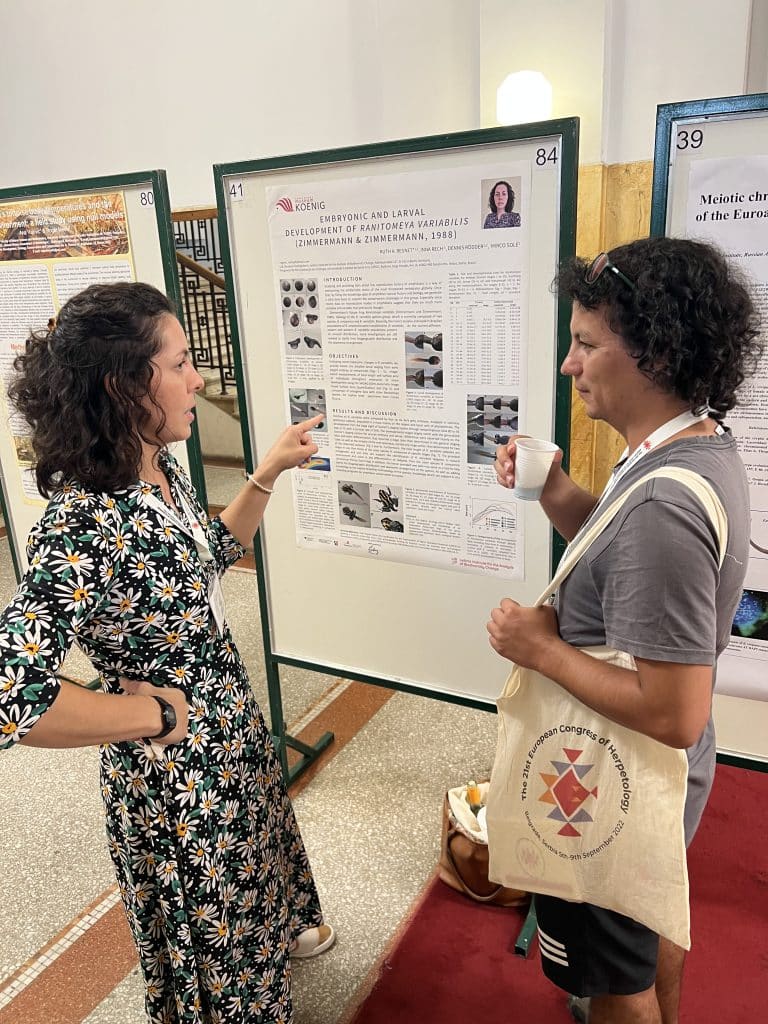
Poster presentation
Captive breeding, embryonic and larval development of the Zimmermann’s poison-frog Ranitomeya variabilis (Zimmermann and Zimmermann, 1988), (Anura: Dendrobatidae)
Regnet R.A.1,2,*, Rech I.1, Rödder D.1,2, Solé M.1,2
1LIB, Museum Koenig Bonn, Leibniz Institute for the Analysis of Biodiversity Change,
Bonn, Germany
2Programa de Pós Graduação em Zoologia, Universidade Estadual de Santa Cruz – (UESC), Salobrinho, Ilhéus, Bahia, Brazil
*Corresponding author (e-mail): Ruth Anastasia Regnet (regnet_ruth@hotmail.com)
Following recent taxonomic changes in Ranitomeya variabilis (Zimmermann and Zimmermann, 1988), we provide herein, for captive bred specimens from French Guiana a description of husbandry in captivity; image-based measurements of total length (TOL) and surface area of individuals throughout embryonic to larval development using the SAISAQ (Semi-Automatic Image based Surface Area Quantification) tool. Furthermore, we provide a detailed larval staging from early staged embryo to metamorph. Clutches of R. variabilis were composed of four to six dark grey eggs, deposited in a mass and wrapped in a colorless gelatinous capsule. Deposition occurs mainly on the largest and basal axils of phytotelma, and less often in photographic film containers, offered as artificial phytotelma. The obtained growth data by SAISAQ showed in comparison with SAISAQ data of other Ranitomeya species a similar growth pattern. However, we noted a remarkable TOL difference between R. variabilis and other Ranitomeya tadpoles, which was also traceable in the ontogenetic data. The developmental stages largely corroborate with the generalized Gosner’s staging system for anuran embryos and larvae. Development from stage eight of Gosner through metamorphosis took 80 to 91 days, with a survival rate of 54%. Differences were observed mainly on the labia and teeth differentiation, which occurred a stage later than expected in the general staging system. As well as, the atrophy of the oral apparatus, which started one stage earlier than expected in two tadpoles. The provided data brings new knowledge about the reproductive biology of this species and supports in situ breeding programs for conservation purposes. We are confident that these data can support the identification of R. variabilis tadpoles in natural environment and the differentiation of tadpoles from the sister species R. amazonica. As well as, providing new data, that can help to clarify the biogeographic distribution and taxonomic arrangement of the species.

Poster presentation
Niche differentiation in the relict, endemic spiny frogs Allopaa hazarensis and Chrysopaa sternosignata
Hofmann S.1,*, Masroor R.2, Litvintchuk S.3, Vershinin V.4, Jablonski D.5
1Museum Koenig Bonn, LIB – Leibniz Institute for the Analysis of Biodiversity Change, Bonn, Germany
2Pakistan Museum of Natural History, Garden Avenue, Shakarparian, Islamabad, Pakistan
3Institute of Cytology, Russian Academy of Sciences, St. Petersburg, Russia
4Institute of Plant and Animal Ecology, Russian Academy of Sciences, Ekaterinburg, Russia
5Comenius University in Bratislava, Bratislava, Slovakia
*Corresponding author (e-mail): Sylvia Hofmann (s.hofmann@leibniz-zfmk.de)
The relict, endemic taxa Allopaa and Chrysopaa are key elements of the Hindu Kush-Himalayan amphibian fauna and share an early-Miocene evolution, making them important proxies for the reconstruction of the Paleogene history of the Tibetan Plateau and the evaluation of respective modern scenarios of the development of the HTO. However, there is no much information on the distribution of these taxa. We here provide species distribution models for both taxa and test the hypotheses of niche differentiation. The average performance of our MaxEnt models was considered significantly better than random. They show, that both taxa are geographically separated with an allopatric distribution pattern, and that BIO8 (mean temperature of wettest quarter) was most important to the models. Further, our findings provide strong support for distinct niche divergence among C. sternosignata and A. hazarensis. The study contributes to the knowledge about the distribution of these species and provide basic information for guiding future management of them.
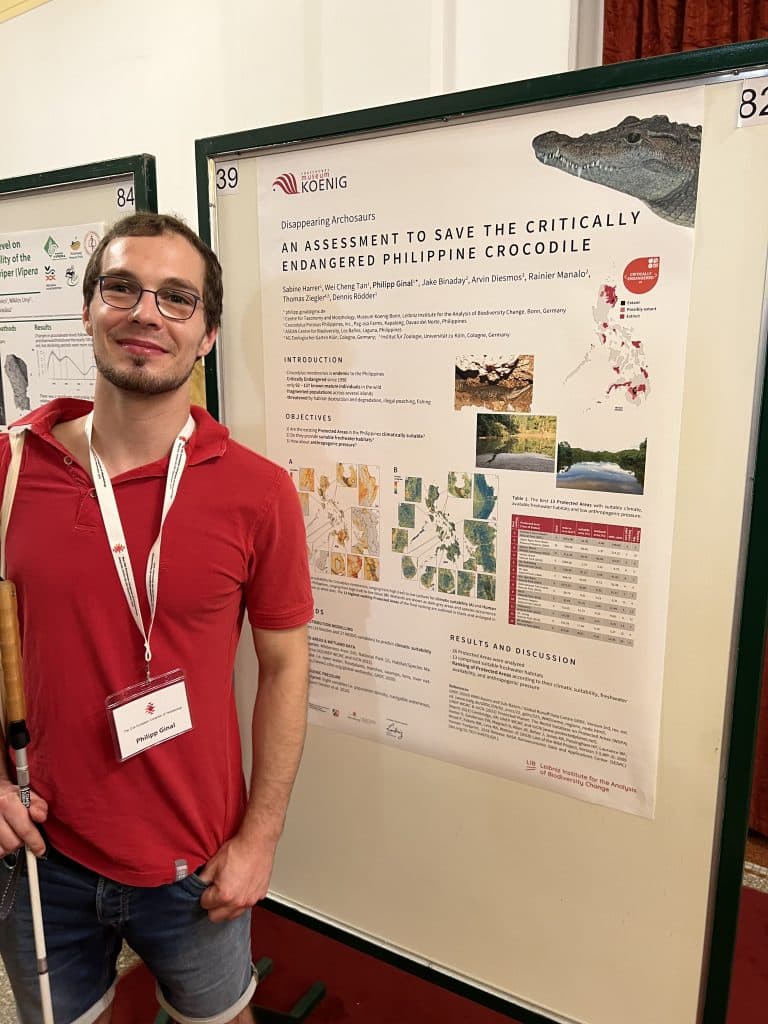
Poster presentation
Disappearing archosaurs – an assessment of established protected areas in the Philippines to save the Critically Endangered and endemic philippine crocodile Crocodylus mindorensis
Harrer S.1, Tan W.C.1, Ginal P.1,*, Binaday J.1, Diesmos A.1, Manalo R.1, Ziegler T.2,3,
Rödder D.1
1LIB, Museum Koenig Bonn, Bonn, Germany
2AG Zoologischer Garten Köln, Köln, Germany
3Institut für Zoologie, Universität zu Köln, Köln, Germany
*Corresponding author (e-mail): Philipp Ginal (philipp.ginal@gmx.de)
Once distributed all over the Philippines, the endemic Philippine Crocodile Crocodylus mindorensis is threatened with extinction. Less than 140 mature individuals live in the wild. Human activities like fishing and illegal poaching, as well as land-use change and habitat conversion cause a continuing threat for the remaining populations. Therefore, designated protected areas were evaluated with species distribution models (SDMs) for improved future conservation efforts. For this purpose, the existing IUCN-reserves were analysed for climatical suitability (combining bioclimatic and remote sensing variables), wetland occurrences and the human footprint index by using MaxEnt and QGIS. Based on topical species records, our final SDM-model showed high performance and revealed the climatically most suitable areas on Luzon and Mindanao. However, only small parts of the climatically optimal area and suitable wetlands are currently covered by reserves. Case in addition, none of the species’ records is located within a protected area. The anthropogenic pressures in the reserves were diverse and varied between a low and moderate level. Most of the records are found in areas with a moderate to medium human footprint. Considering the three criteria, only ‘Northern Sierra Natural Park’, ‘Agusan Marsh Wildlife Sanctuary’ and ‘Upper Agno River Basin Resource Reserve’ revealed to be suitable conservation areas for C. mindorensis. The other reserves seemed to be unsuitable, whereas suitable areas outside protected areas are highly recommended for further surveys. Therefore, the current network of existing protected areas needs significant improvement to provide well-suited and long-term protection for C. mindorensis. More surveys are also necessary to find hidden, so far overlooked populations and verify C. mindorensis tolerance level for human footprint.




















In the realm of fungi – a pathogen leads to mass death
Learn more about the history of emerging pathogens in amphibians in our recent podcast (in german). This time the Pandemia team is not dealing with a virus or a bacterium, but with a fungus: Batrachochytrium dendrobatidis. This pathogen has led to a worldwide mass extinction of amphibians in the last few decades. Australian researcher Lee Berger tells how she discovered the pathogen in the 1990s and why it was initially ignored. Herpetologists Ben Scheele and Dennis Rödder explain how the fungus could spread and what that has to do with an early pregnancy test.
Italian Cave Salamanders in Germany?
Non-native species are among the main factors for the loss of biodiversity. For amphibians, especially some frogs and toads (i.e. Cane Toad or African Clawed Frog) have strong negative impact on ecosystems where these species do not belong. In contrast, only few cases are known where salamanders or newts were found in non-native ecosystems.
Cave Salamanders of the genus Speleomantes are endemic to France and Italy, with three species occurring across the Apennine mountain chain on the European mainland and five species on Sardinia. The common name Cave Salamanders is misleading as members of this genus are no obligate cave dwellers. However, Speleomantes are often found in caves but also in other habitats such as mines or crevices, where a moist and cold environment is provided over the whole year. These environmental conditions are necessary for efficient cutaneous respiration as Cave Salamanders are lungless. Since 2013, it is known that an introduced population of Cave Salamanders occur in the Weserbergland/Solling, Lower Saxony, Germany.
However, the identification of Speleomantes based on morphology is difficult and thus the identity of the German population was unknown and studies were lacking. Further, it was unclear if the German population is composed of just a few individuals that persist there for some years or if it is a reproducing, established population. For this reason, the Biologists Philipp Ginal (Zoological Research Museum Koenig in Bonn) and Carl-Henning Loske (Engineer Office Loske) visited the study area several times to collect and photograph the Cave Salamanders. On six capture events during the autumn of last year, the scientists found 70 different individuals of salamanders with only three individuals captured twice. Together with the colleagues Dennis Rödder (Zoological Research Museum Koenig in Bonn) and Thomas Hörren (University of Duisburg-Essen), capture-recapture models were calculated to estimate the population size.
As Cave Salamanders have a unique color pattern when they are adult, an individual identification is possible. Further, a recently published photographic database, comprising more than 1000 images of all eight Cave Salamander species, was used to give a tentative species identification of the German population. Our capture-recapture models estimate a population size between 170 and 485 individuals. Our results show that the German population is much larger than previously expected. However, the minimum estimate of 170 individuals is very unlikely and more realistically the population is much larger than this estimate. Additionally, we found that morphologically only some populations of the species S. italicus were identical to the German population. S. italicus is native to the northern and central Apennines.
Our tentative species identification was already proofed by genetic analyses of colleagues from the University Braunschweig. Further during field work, we could find juvenile Cave Salamanders as well as a pregnant female, which provides evidence for a reproducing population of Cave Salamanders in Germany. As Cave Salamanders are not native in Germany, future monitoring of the German population is required. However, yet the population seems to be restricted to a single rock scarp of c. 40 m length and negative impacts on the native fauna as well as concurrence with other amphibian species could not be observed yet. Sometimes the Cave Salamandes found together with the native Fire Salamanders or Alpine Newts in the same crevices.
Original publication:
Ginal, P., Loske, C. H., Hörren, T., & Rödder, D. (2021). Cave salamanders (Speleomantes spp.) in Germany: tentative species identification, estimation of population size and first insights into an introduced salamander. Herpetology Notes, 14, 815-822.

Caption: A specimen of the small population of cave salamanders in Weserbergland/Solling, Lower Saxony The animals have now been determined as Speleomantes italicus by genetic evidence and external appearance. How the species arrived at this location remains unknown.
Mögliche invasive Bedrohung durch den Afrikanischen Krallenfrosch wesentlich größer als gedacht – – mechanistische Modelle im Kampf gegen die unerwünschten Auswirkungen einzelner, verschleppter Arten
21.01.2021 Ein internationales Forscherteam um die beiden Herpetologen Philipp Ginal und Dennis Rödder vom Zoologischen Forschungsmuseum Koenig – Leibniz-Institut für Biodiversität der Tiere (ZFMK, Museum Koenig) nutzen einen neuen Ansatz zur Abschätzung des invasiven Potenzials einer Art. In einem ganz neuen Licht muss danach die Bewertung des Invasionsrisikos des Krallenfroschs gesehen werden. Die neue Berechnung weist in Europa ein Gebiet von fast zwei Millionen km2 möglichen Lebensraums für den Afrikanischen Krallenfrosch aus. Das ist etwa das Doppelte der Fläche, die man bisher angenommen hatte. Die Gefahr, dass die Art nicht ursprüngliche Heimatgebiete massiv negativ beeinflussen wird, ist also wesentlich größer als bisher gedacht. Hinzu kommt, dass es auch schon erste Anzeichen gibt, dass sich in Frankreich eingeschleppte Tiere bereits an das dortige Klima anzupassen beginnen und stark auf dem Vormarsch sind. Das mechanistische Model wurde jetzt im Journal of Experimental Zoology Part A: Ecological and Integrative Physiology beschrieben.
Der Afrikanische Krallenfrosch, Xenopus laevis, stammt ursprünglich aus dem südlichen Afrika. Die Art wurde in der Vergangenheit als Schwangerschaftstest und Modelorganismus für verschiedene Forschungsbereiche genutzt, was dafür sorgte, dass entkommene oder ausgesetzte Krallenfrösche invasive Populationen auf vier weiteren Kontinenten etablieren konnten. Mittlerweile gibt es sogar mehrere Populationen in Frankreich, Italien und Portugal. In den dortigen Ländern richtet die nicht-einheimische Art als Nahrungskonkurrent und Fressfeind großen Schaden an den dortigen Ökosystemen an. Zudem gilt der Krallenfrosch als Überträger des für Amphibien tödlichen Chytridpilzes (Batrachochytrium dendrobatidis), der neben der Habitatzerstörung einer der Hauptursachen des weltweiten Amphibiensterbens ist.
Eine Möglichkeit um das Risiko des invasiven Potenzials nicht-einheimischer Arten, die sich rasch ausbreiten können, abzuschätzen, ist das sogenannte Species Distribution Modelling, auch SDM genannt. Durch diese mathematischen Modelle kann vorhergesagt werden, welche geographischen Gebiete sich auf Grund der Umweltbedingungen für eine Art theoretisch eignen. Bisherige SDMs für den Afrikanischen Krallenfrosch haben jedoch nur einen Bruchteil der klimatischen Nische des Froschlurchs erfasst und somit nicht alle Gebiete, die klimatisch für die Art geeignet sind, vorhergesagt. Nun hat ein internationales Forscherteam um die beiden Herpetologen Philipp Ginal und Dennis Rödder vom Zoologischen Forschungsmuseum Koenig in Bonn im Rahmen des von BiodivERsA und durch die DFG geförderten INVAXEN-Projekts einen neuen Ansatz verwendet. „Mit unserem neuen Ansatz konnten wir durch Laborversuche die kritischen Minimal- und Maximal-, sowie Optimaltemperaturen ermittelt, unter denen der Frosch überleben kann“ erläutert Ginal die neue Vorgehensweise. Unter Berücksichtigung dieser physiologischen Eigenschaften wurde dann die potenziell mögliche Verbreitung in Europa vorhergesagt.
Mit Hilfe dieser sogenannten mechanistischen SDMs lässt sich die zukünftig prinzipiell mögliche Verbreitung einer Art genauer vorhersagen als mit den vorher verwendeten Methoden. „Durch den innovativen methodischen Ansatz war es sogar möglich die physiologischen Limits verschiedener Entwicklungsstadien, wie Kaulquappen und erwachsene Frösche, in das Model einzuspeisen, was vorher ebenfalls nicht möglich war“ legt Rödder dar. Die Ergebnisse der Studie von Ginal et al. (2020) zeigen, dass allein in Europa ein Gebiet von fast zwei Millionen km2 für den Afrikanischen Krallenfrosch geeignet ist. Die vorherigen Methodenansätze hatten dagegen lediglich maximal die Hälfte der Fläche vermuten lassen. Insbesondere Süd- und Westeuropa sind laut den Modellen der Forscher besonders gut für den Frosch geeignet. Aber auch vereinzelte Gebiete in Deutschland scheinen dem Klima des Froschs zu entsprechen.
Dies wirft ein ganz neues Licht auf die Bewertung des Invasionsrisikos des Krallenfroschs, berücksichtigt man, dass es auch schon die ersten Anzeichen gibt, dass sich die in Frankreich eingeschleppten Tiere bereits an das dortige Klima anzupassen beginnen und stark auf dem Vormarsch sind. In zukünftigen Studien planen die Forscher die Auswirkungen der lokalen Anpassung an das europäische Klima zu untersuchen, um weitere Erkenntnisse über den Afrikanischen Krallenfrosch in Europa zu sammeln und so den höchst invasiven Froschlurch von seinem Vormarsch abzuhalten.
Bildunterschrift: Rund zwei Millionen km2 sind als potenziell mögliches Habitat für den Afrikanischen Krallenfrosch in Europa vorhergesagt (Abb. oben). Zur Überprüfung der Korrektheit der mechanistischen Modelle haben die Forscher auch die Verbreitung der Art in ihrem natürlichen Lebensraum im südlichen Afrika korrekt vorhergesagt (in der Abbildung unten links).

Literatur: Ginal, P., Mokhatla, M., Kruger, N., Secondi, J., Herrel, A., Measey, J., & Rödder, D. (2020). Ecophysiological models for global invaders: Is Europe a big playground for the African clawed frog?. Journal of Experimental Zoology Part A: Ecological and Integrative Physiology.
Predicting terrestrial dispersal corridors of the invasive African clawed frog Xenopus laevis in Portugal
Invasive species such as the African Clawed Frog, Xenopus laevis, are a main threat to global biodiversity. Xenopus is native to Southern Africa but was introduced to four other continents. In Europe, the species could establish populations in France, Italy and Portugal. In our recently published study, we provide a novel approach, which was used to reconstruct the invasion of this highly invasive frog for Portugal. Using satellite data, including data on elevation, vegetation and land cover, we found that this almost fully aquatic frog most likely used a terrestrial corridor with three golf course ponds next to Laje River to reach a second river. Further, we give recommendations about possible future corridors, which will support the Portuguese eradication program for this frog.
Ginal, P., F. D. Moreira, R. Marques, R. Rebelo, and D. Rödder. 2021. Predicting terrestrial dispersal corridors of the invasive African clawed frog Xenopus laevis in Portugal. NeoBiota 64: 103–118.








